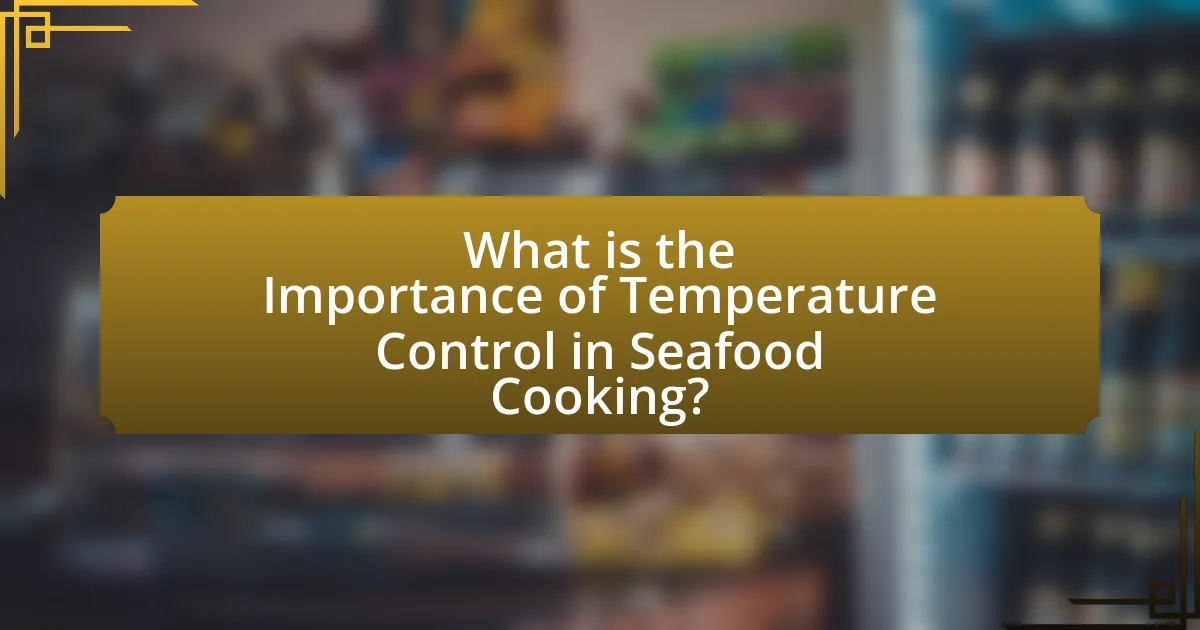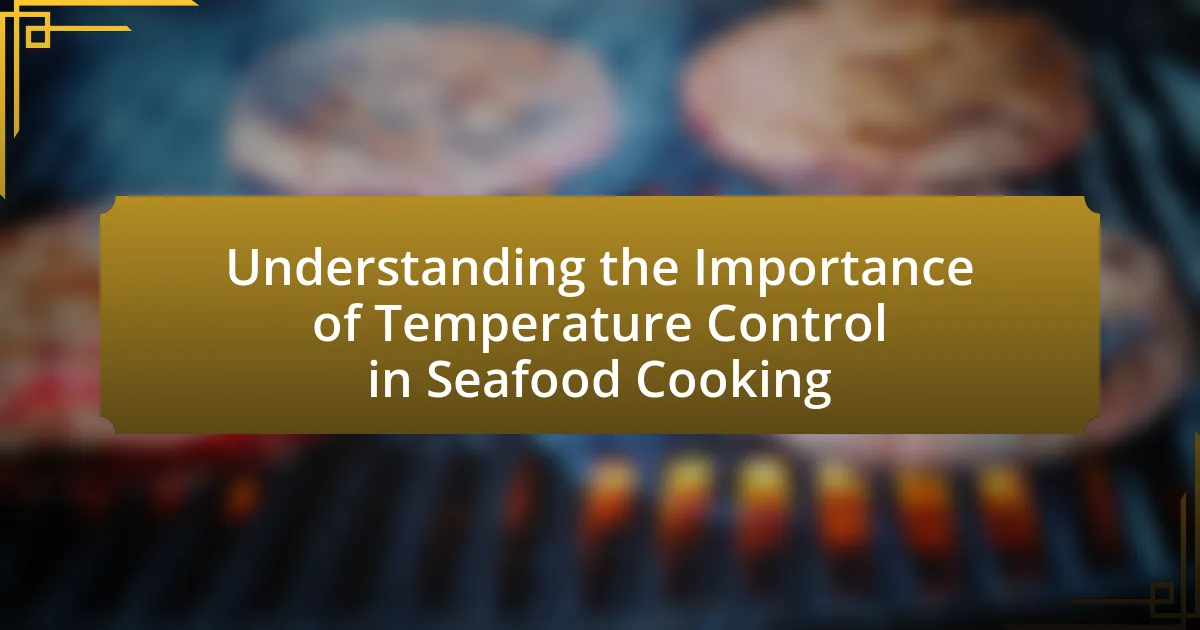Temperature control is a critical aspect of seafood cooking that ensures food safety and enhances flavor and texture. Cooking seafood to the recommended internal temperature of 145°F (63°C) effectively eliminates harmful pathogens such as Vibrio and Salmonella, reducing the risk of foodborne illnesses. Proper temperature management also preserves the delicate qualities of seafood, preventing overcooking and maintaining moisture. The article outlines the importance of temperature control, the risks associated with improper cooking, recommended temperature guidelines for various seafood types, and effective tools and techniques for achieving precise temperature management in the kitchen.

What is the Importance of Temperature Control in Seafood Cooking?
Temperature control in seafood cooking is crucial for ensuring food safety and achieving optimal flavor and texture. Proper cooking temperatures kill harmful bacteria and parasites, reducing the risk of foodborne illnesses; for instance, cooking fish to an internal temperature of 145°F (63°C) is recommended by the USDA to ensure safety. Additionally, maintaining the right temperature helps preserve the delicate texture and moisture of seafood, preventing it from becoming overcooked and rubbery. Therefore, effective temperature control is essential for both health and culinary quality in seafood preparation.
Why is temperature control critical in cooking seafood?
Temperature control is critical in cooking seafood to ensure food safety and optimal texture. Seafood is highly perishable and can harbor harmful bacteria, such as Vibrio, which thrive at improper temperatures. Cooking seafood to an internal temperature of at least 145°F (63°C) effectively kills these pathogens, reducing the risk of foodborne illness. Additionally, precise temperature management prevents overcooking, which can lead to a rubbery texture and loss of flavor, ensuring that seafood retains its desirable qualities.
What are the risks of improper temperature control in seafood cooking?
Improper temperature control in seafood cooking poses significant health risks, primarily due to the potential growth of harmful bacteria and parasites. Seafood, when not cooked to the appropriate internal temperature of 145°F (63°C), can harbor pathogens such as Vibrio, Salmonella, and Listeria, which can lead to foodborne illnesses. According to the Centers for Disease Control and Prevention (CDC), approximately 80,000 cases of Vibrio infections occur annually in the United States, often linked to undercooked seafood. Additionally, improper temperature control can result in the survival of parasites like Anisakis, which can cause severe gastrointestinal issues. Therefore, maintaining proper cooking temperatures is crucial to ensure food safety and prevent these health risks.
How does temperature affect the texture and flavor of seafood?
Temperature significantly influences the texture and flavor of seafood. Cooking seafood at appropriate temperatures ensures that proteins denature correctly, resulting in a tender texture, while overcooking can lead to a rubbery consistency. For instance, fish typically becomes flaky and moist when cooked to an internal temperature of 145°F (63°C), while temperatures above this can cause proteins to tighten excessively, resulting in dryness. Additionally, lower cooking temperatures, such as those used in sous-vide methods, can enhance the natural flavors of seafood by allowing for more even cooking and retention of moisture. Studies have shown that cooking seafood at lower temperatures can preserve delicate flavors and improve overall palatability, making temperature control crucial in seafood preparation.
What are the recommended temperature ranges for cooking different types of seafood?
The recommended temperature ranges for cooking different types of seafood are as follows: fish should be cooked to an internal temperature of 145°F (63°C), shellfish like shrimp and lobster should reach 145°F (63°C), while clams and mussels should be cooked until their shells open, indicating they are done. These temperatures ensure that seafood is safe to eat and helps maintain its quality. The U.S. Food and Drug Administration (FDA) provides these guidelines to prevent foodborne illnesses associated with undercooked seafood.
How do cooking methods influence the required temperature for seafood?
Cooking methods significantly influence the required temperature for seafood by determining how heat is applied and the desired doneness. For instance, methods like poaching and steaming typically require lower temperatures, around 140°F to 160°F, to gently cook seafood without drying it out. In contrast, grilling or broiling often necessitates higher temperatures, approximately 400°F to 500°F, to achieve a desirable sear and flavor while ensuring the seafood reaches a safe internal temperature of at least 145°F. These temperature variations are essential for both safety and quality, as undercooked seafood can pose health risks, while overcooking can lead to a loss of texture and flavor.
What are the specific temperature guidelines for fish, shellfish, and crustaceans?
The specific temperature guidelines for fish, shellfish, and crustaceans are as follows: fish should be cooked to an internal temperature of 145°F (63°C), shellfish such as shrimp, lobster, and crabs should also reach 145°F (63°C), and clams, oysters, and mussels should be cooked until their shells open, indicating they have reached a safe temperature. These guidelines are established by the U.S. Food and Drug Administration (FDA) to ensure food safety and prevent foodborne illnesses.
How can temperature control enhance food safety in seafood cooking?
Temperature control enhances food safety in seafood cooking by ensuring that seafood is cooked to the appropriate internal temperature, which kills harmful pathogens. For instance, cooking fish to an internal temperature of 145°F (63°C) effectively eliminates bacteria such as Salmonella and Vibrio, which can cause foodborne illnesses. Additionally, maintaining proper temperatures during storage and cooking prevents the growth of these pathogens, as they thrive in the temperature danger zone of 40°F to 140°F (4°C to 60°C). Therefore, effective temperature management is crucial for minimizing health risks associated with seafood consumption.
What are the common foodborne pathogens associated with seafood?
Common foodborne pathogens associated with seafood include Vibrio species, Salmonella, Listeria monocytogenes, and Clostridium botulinum. Vibrio species, particularly Vibrio parahaemolyticus and Vibrio vulnificus, are often linked to raw or undercooked shellfish and can cause gastrointestinal illness. Salmonella can contaminate seafood through improper handling or cross-contamination, leading to food poisoning. Listeria monocytogenes is a concern in ready-to-eat seafood products and can cause severe illness, especially in vulnerable populations. Clostridium botulinum, while less common, can produce toxins in improperly canned or preserved seafood. These pathogens highlight the critical need for temperature control during seafood cooking to prevent foodborne illnesses.
How does proper cooking temperature eliminate these pathogens?
Proper cooking temperature eliminates pathogens by denaturing proteins and disrupting cellular structures, effectively killing harmful microorganisms. For instance, cooking seafood to an internal temperature of 145°F (63°C) is scientifically proven to destroy bacteria such as Vibrio and Salmonella, which can cause foodborne illnesses. Research indicates that maintaining this temperature for a minimum of 15 seconds is sufficient to ensure the safety of the food, as it leads to the inactivation of these pathogens.
What tools and techniques can be used for effective temperature control in seafood cooking?
Effective temperature control in seafood cooking can be achieved using tools such as digital thermometers, sous-vide machines, and induction cooktops. Digital thermometers provide precise temperature readings, ensuring seafood is cooked to safe internal temperatures, typically around 145°F (63°C) for fish, which helps prevent foodborne illnesses. Sous-vide machines allow for consistent temperature control by cooking seafood in a water bath at a set temperature, preserving moisture and flavor. Induction cooktops offer rapid heating and precise temperature adjustments, making it easier to maintain the desired cooking temperature. These tools, combined with techniques like monitoring cooking times and using ice baths for rapid cooling, enhance the quality and safety of seafood dishes.
How do thermometers and other devices aid in temperature monitoring?
Thermometers and other devices aid in temperature monitoring by providing accurate measurements of temperature, which is crucial for ensuring food safety and quality. These instruments, such as digital thermometers and infrared thermometers, allow cooks to monitor the internal temperature of seafood, ensuring it reaches safe cooking temperatures to eliminate harmful bacteria. For instance, the USDA recommends that fish should be cooked to an internal temperature of 145°F (63°C) to ensure safety. By using these devices, chefs can prevent undercooking or overcooking, which can affect both the safety and texture of seafood dishes.
What are the best practices for using these tools in the kitchen?
The best practices for using kitchen tools involve ensuring proper temperature control, especially when cooking seafood. Maintaining the correct temperature is crucial to prevent foodborne illnesses and to achieve optimal texture and flavor. For instance, using a food thermometer to check that seafood reaches an internal temperature of 145°F is essential for safety and quality. Additionally, tools like sous vide machines can provide precise temperature control, allowing for consistent results. Proper cleaning and maintenance of these tools also enhance their effectiveness and longevity, ensuring they function correctly during cooking.
How can one ensure consistent temperature control when cooking seafood?
To ensure consistent temperature control when cooking seafood, one should use a reliable food thermometer to monitor the internal temperature accurately. Cooking seafood at the correct temperature, typically between 145°F (63°C) for fish and 145°F (63°C) for shellfish, prevents overcooking and maintains texture and flavor. Additionally, preheating the cooking surface and using techniques such as sous-vide can help maintain a steady temperature throughout the cooking process. Studies show that precise temperature control reduces the risk of foodborne illnesses associated with seafood, reinforcing the importance of accurate cooking methods.
What are the common mistakes to avoid in seafood cooking temperature management?
Common mistakes to avoid in seafood cooking temperature management include not using a food thermometer, cooking seafood at incorrect temperatures, and failing to account for carryover cooking. Not using a food thermometer can lead to undercooked seafood, which poses health risks, as seafood should reach an internal temperature of 145°F to ensure safety. Cooking seafood at incorrect temperatures, such as too low, can result in a rubbery texture, while cooking at excessively high temperatures can dry it out. Additionally, failing to account for carryover cooking, where seafood continues to cook after being removed from heat, can lead to overcooking. These mistakes can compromise both safety and quality in seafood preparation.
How can one adjust cooking times based on thickness and type of seafood?
To adjust cooking times based on thickness and type of seafood, one must consider that thicker pieces of seafood require longer cooking times, while thinner pieces cook more quickly. For example, a 1-inch thick salmon fillet typically takes about 10-12 minutes to cook at 400°F, whereas a ½-inch thick fillet may only need 6-8 minutes. Additionally, different types of seafood have varying cooking times; for instance, shrimp cook rapidly, usually in 3-5 minutes, while larger shellfish like lobster may take 8-12 minutes depending on size. This variation is due to differences in density and moisture content among seafood types, which affects heat penetration and cooking efficiency.
What are some practical tips for mastering temperature control in seafood cooking?
To master temperature control in seafood cooking, use a reliable instant-read thermometer to ensure precise cooking temperatures. For example, fish should be cooked to an internal temperature of 145°F (63°C) to ensure safety and optimal texture. Additionally, consider the cooking method; poaching and steaming require lower temperatures, around 160°F (71°C), while grilling or broiling can reach higher temperatures. Monitoring the cooking time is also crucial, as seafood cooks quickly; for instance, shrimp typically takes only 2-3 minutes per side. Lastly, allow seafood to rest for a few minutes after cooking to let the juices redistribute, enhancing flavor and moisture.

Leave a Reply